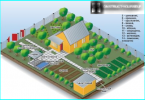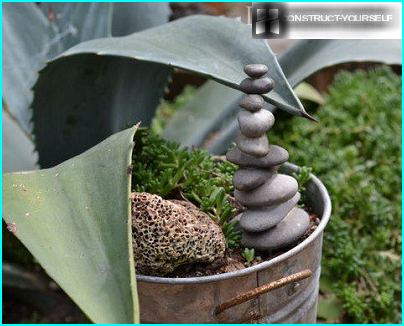
In bulbous flowers has its own special charm – the leaves and stems are surprisingly delicate, smooth and rich, and the flowers are distinguished by a subtle, sweet smelling fragrance. Suffice it to recall the smell of daffodils and hyacinths. Blooming bulbs are one of the first, decorating the garden, only woken up after the cold winter. Planting bulbs in the winter is the key to its spring beauty and brightness, so if you want to spring in your area it is as early as possible, flower gardens onion of certain varieties need to be addressed in September. What flower bulbs are planted with the onset of autumn and how to carry out a landing?
The contents
Melkolukovichnye, which include Scylla, snowdrops, Muscari, crocuses are planted in early September in the southern regions of the country – in October. These plants are very tiny, and elegant, they look most effectively in open areas, planted by the group. But first snowdrop you will be pleased with nothing less than a luxurious bed.
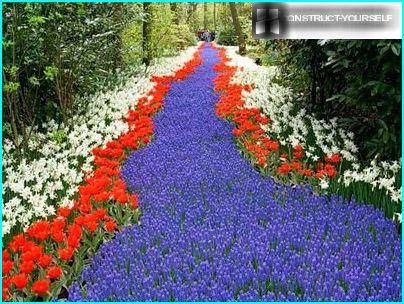
A garden can be beautiful any time of year, in early spring this will help make the onion, if engaged in planting these flowers in the fall
Tulips, daffodils, lilies, whose bulbs are larger, can be planted in late September to end of October. You want the onion is well entrenched that it has formed a root system, but it did not have time to germinate before the cold weather.
Flower bulbs for the garden can be grown as an annual and perennial. If you don’t dig up the bulbs autumn bulbs after flowering and leave them to winter, they will bloom next year. Although over time the varietal traits will be lost, and plants will need to be updated.
Selection of the place and soil for the planting of
Bulbous plants grow and bloom when the trees have not yet blossomed, so they can be planted under trees or shrubs. In rockeries or Alpine hill will especially look good crocuses, Scylla (better known as Scilla).

Bright colors poleskov appear when the snow has not quite gone. These first messengers of spring planted in groups, look very picturesque on the hills and open areas
Bulbs grow well in fertile soil, where water does not stagnate. If you have a plot of ground clay, it has to be mixed with sand, sometimes done and drainage of heavy soils. The soil is prepared for planting a few days – fertilized, watered, compacted, if necessary.
The General rule of planting bulbs
Planting bulbs in the fall begins with the inspection of bulbs. The flowers grew well and not sick, before planting you need to pay attention to the condition of the bulbs. If they have minor damage, the bulbs can be treated in a solution of manganese, the location of damage are also handled by the brilliant green. The bulbs rotting or disease throw, otherwise you get sick can all the flowers in the garden.
On a prepared surface to remove the top layer of the soil, the bottom can be filled fine sand, bulbs are laid at a small distance from each other. Each onion should be slightly flatten and fill the earth. If the clay soil for better growth of flowers soil backfill mixed with humus or peat. The landing area is mulched, watered, it is better to note the pegs to spring accidentally dig.
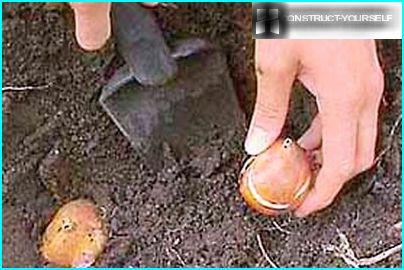
When purchasing bulbs in an opaque package can be purchased diseased or damaged, small damage you can try to treated with brilliant green or manganese, but perfect for planting strong and healthy bulbs without sprouts
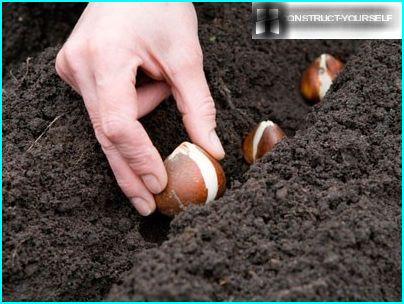
Planting bulbs in loose, fertile soil does not require drainage, it is sufficient to make a recess to position the bulbs at a certain distance, covered with soil and watered
On the lawn to plant bulbs easier – removed a layer of turf, in the loosened soil is placed onion and covered with turf.
Overview of preferences the most popular varieties
Mouse hyacinths or Muscari (Lily family)
Grow well in loose, drained soil, like sunlight. The bulbs are deepened by 8 cm in the soil layer, the distance between them was 7-8 cm.
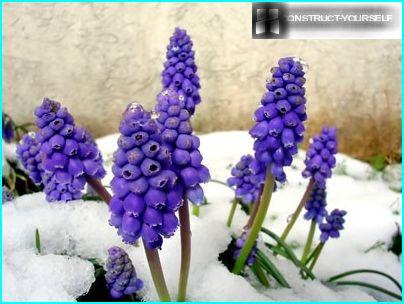
Muscari — flowers, which appear, when there came down the snow and continue to bloom, when the trees dress leaves. Their delicate blossoms — a real decoration of the garden
Crocus (family iridaceae)
These colors are perfect for a permeable soil, good lighting. Planting depth and distance between bulbs is the same as when planting Muscari.
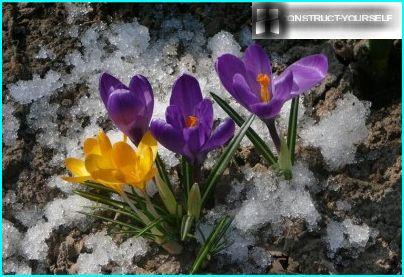
The bulbs of crocuses reproduce well, they need to sit down every 2-3 years. Much to worry about the depth of planting is not necessary, these flowers are great zaglubljajutsja themselves
Article topic: Planting, growing and care of bulbous irises — a gardeners secrets
Daffodils (amaryllidaceae)
Can grow in partial shade and in the sun, in a light permeable soil. Time of planting – August-October.
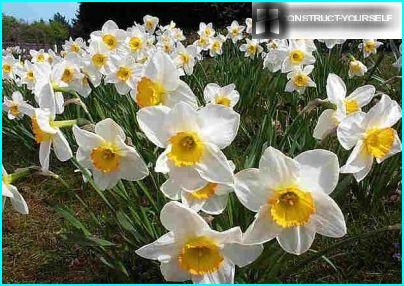
Daffodils do not like to live in the soil fertilized with manure, wetlands, and highly calcareous soil. The PH of the soil neutral is desirable, however, they grow well in slightly acidic lands
Tulips (Liliaceae)
Tulips – garden bulbs flowers never cease to amaze with their perfection and variety of shapes and colors. In addition, they are unpretentious and do not require special conditions for flowering and growth.
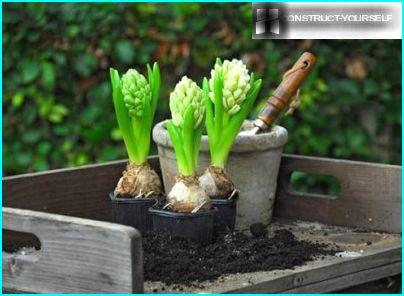
Tulip bulbs are planted depending on the size at a distance of 10-20 cm from each other towards the end of autumn, did not have time to germinate
Lilies (Liliaceae)
The best soil for lilies – fertilized and drained. Varieties of lilies a lot, so the landing time and distance and depth between bulbs depends largely on the specific species.
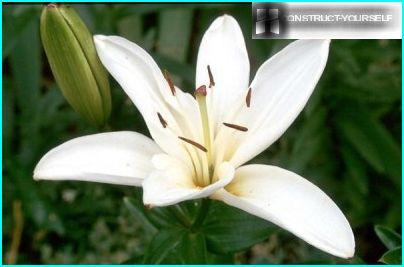
Lily bulbs should be thick, without a germ, if the germ is still there, it needs to be cut, and the onion to plant a little deeper
Grouse, of Fritillaria (Liliaceae)
A fairly rare plant in our flowerbeds. Orange Fritillaria often mistaken for lilies. Like all bulbs, likes drained soil and bright lighting. The bulb is planted at a distance equal to double its height, these plants look good both solo and in group.
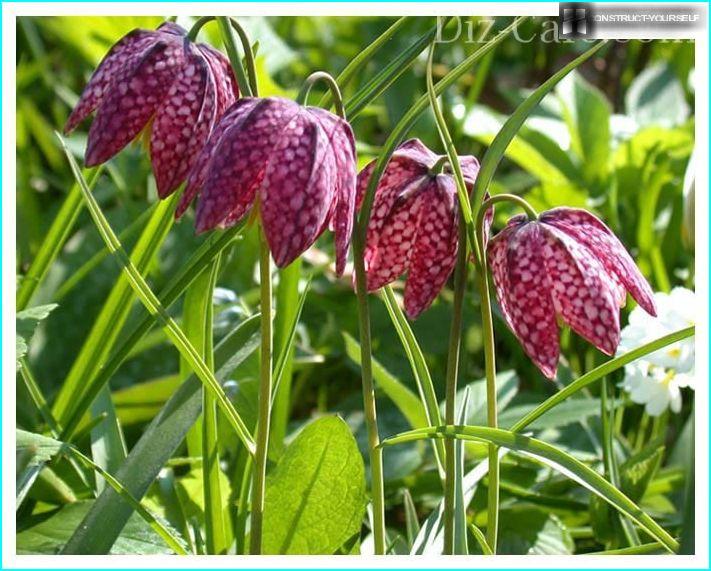
Fritillaria also called the grouse because of the variegated colors. Drooping blossoms look unusual, attracting the attention
The cultivation of different varieties of bulbous flowers is based on a total of simple rules, following which you can grow a beautiful live decoration for your garden. But innovations today a lot, and if you are interested in something, about the rules of care for a new miracle selection need to enquire.






